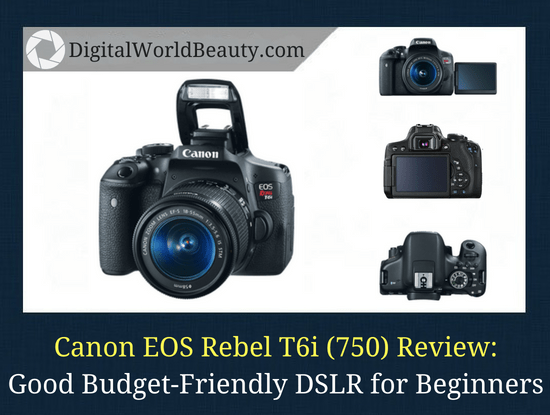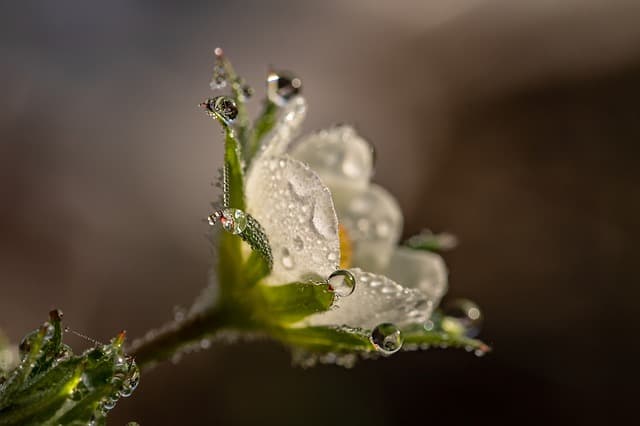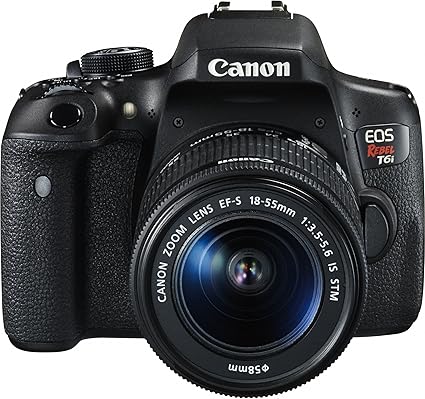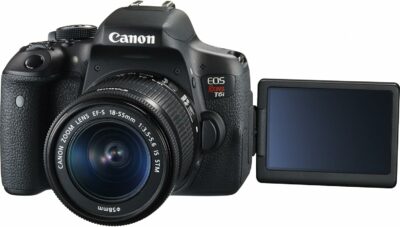Please note: As an Amazon Associate I earn from qualifying purchases. I also work with other affiliate partners and may be compensated from the links below. Details here.
Canon EOS Rebel T6i in 2025: Budget-Friendly DSLR for Beginners (Review)

Welcome to my Canon EOS Rebel T6i review! (2025 Update)
You may wonder…
- Is Canon T6i a good camera by today’s standards?
- What’s so great about it besides its price?
- Is the Canon T6i Rebel worth buying in 2025?
The Canon Rebel T6i release date was in April 2015, making it nearly a decade old, yet it remains competitive in today’s market.
Despite its age, the Canon T6i price range of over $700 for a complete kit still offers excellent value for money.
Without a doubt, this DSLR would be a lovely purchase especially if you’re a beginner.
This compact body has a lot of advantages such as the 24 MP sensor, fast autofocus, articulated touch screen, awesome work in Auto mode, just to name a few.
Overall, I would say that buying a Rebel T6i would be a good budget-friendly DSLR investment in your future as a photographer.
Canon T6i Review 2025 (Summary)
Type: Compact SLR | Weight: 555 g | Resolution: 24 MP | Sensor size: APS-C (22.3 x 14.9 mm) | ISO: Auto, 100-12800 (expandable to 25600) | LCD screen: Fully articulated | Touchscreen: Yes | Environmentally sealed: No
Reasons to Buy:
- remote control available
- large buffer for JPG photos
- awesome work in Auto mode
- continuous shooting up to 5 fps
- great image quality at high ISO units
- additional Scene modes and creative filters
- fully articulated and responsive touch screen
- 19-point phase autofocus (better than before)
- video shooting with smooth and fast autofocus
Reasons to Avoid:
- small buffer when shooting in RAW
- no HDR and interval shooting mode
- not very well optimized Wi-Fi power consumption
Canon Rebel T6i Specs Overview
Look:
Here are the Canon T6i specs you need to know about.
If we look at the previous Canon models like Canon EOS Rebel T2i (EOS 550D) up to Rebel T5i (EOS 700D), we’ll see that there weren’t any serious innovations.
The cameras kept inheriting the same type of sensor and other similar features.
But finally, Canon followers saw an upgrade with the entry-level EOS Rebel T6i DSLR.
(By the way, if you wonder “Is the 750D the same as the T6i?” then the answer is yes. Rebel T6i is known as Canon EOS 750D outside the North America).
As usual, the Canon EOS xx0D display screen is very comfortable.
An awesome fully articulated 3″ touch screen with a resolution of 1.04 million points was left unchanged, it is just as convenient as its competitor – the Nikon D5500.
For manual focus and input settings on the fly, this is a valuable quality.
Viewing photos on such a screen is a total pleasure, and, in our opinion, this fully articulated feature is more convenient than the one we saw in Nikon D750 full-frame DSLR.
The ability to change the position of the display is excellent when you shoot subjects that are much lower or higher than your eyes (like flowers in a flowerbed, balloons in the sky, artists on the stage), or when sunlight interferes with viewing image details.
The display brightness is adjustable, and its stain-resistant coating makes it easy to shoot under extreme conditions (or when there are children, dogs, food nearby).
Overall, the T6i is pretty fast and you won’t encounter any issues, really.
-
Resolution and Image Quality
Canon decided to raise up the Canon Rebel T6i megapixels from 18MP to 24MP, which is neither good nor bad, as this update wasn’t reflected on the quality of the images.

Some might not find this change in number of megapixels very important.
But they will love the color rendition.
The improvement in color rendition with artificial lighting and photo-sensitivity definitely pleases the eye.
When it comes to Canon T6i picture quality, the camera truly shines.
The 24-megapixel APS-C sensor delivers crisp, detailed images with excellent dynamic range, making it perfect for both beginners learning photography basics and more experienced users looking for reliable results.
About image quality:
Times when a good photo in the room couldn’t be taken without a flash or a high-speed lens are in the past. Now you can safely take photos from ISO up to ISO 12800, without much loss in image quality.
In general, good results with high ISO, as well as convenient control through the touch screen more and more level the difference between the top full-frame cameras and their budget counterparts.
(And this trend is observed with all brands.)
The flash on the Rebel T6i can work in a command mode, and it significantly wins against Nikon’s competitors.
The camera autofocus has now 19 focus points instead of 9, it became faster.
If the additional focus points are just a pleasant trifle, then the speed of autofocus and accuracy during serial shooting has increased noticeably.
-
Burst rate
The camera supports shooting at an exposure of 1/4000 to 30 seconds. When continuous shooting, it can output up to 5 frames per second in JPG and up to 8 in RAW.
This mode is useful when:
- photographing fast-moving children,
- reportage shooting (to avoid photos with open mouth and closed eyes),
- taking group photos, and,
- you shoot important (sports) events‘ moments like jumps, stunts, performances.
In fact:
This burst rate is enough to be considered the best budget Canon DSLR for sports photography (with proper lenses).
-
Li-ion battery (charger included)
Like all amateur Canon SLR cameras, 750D is powered by a lithium-ion battery.
LP-E17 is installed, withstanding at least 440 cycles of recharging. The camera allows you to save energy by automatically turning off the power after a certain period (you can set its duration in the menu).
-
Printing via Wi-Fi
The camera can send photos for printing via Wi-Fi. Direct printing on Canon/Pixma photo printers with PictBridge is supported.
Files are stored on SD, SDHC or SDXC (UHS-I) cards up to 64 GB in size.
Canon T6i shoots in JPEG and RAW of the second version, and video shooting is in MP4 at a resolution of up to 1920×1080 pixels.
-
Video capabilities
The Canon T6i video quality isn’t at the level of professional video-cameras but still delivers impressive results for its class.
I mean the Full HD video shooting is possible with a frequency of up to 30 fps when using autofocus, as well as with auto or manual settings.
-
Built-in Wi-Fi
Canon EOS Rebel T6i, or 750D outside the Americas, is Canon’s budget entry-level DSLR with NFC and Wi-Fi connection.
(Internet technology and gadget fans will absolutely love this feature.)
Initially, it was the Nikon that started the era of budget SLR cameras with a built-in Wi-Fi, with their release of Nikon D5300 in late 2013.
Later, this initiative was intercepted by the updated D5500 model.
Therefore, the Wi-Fi feature in Rebel T6i is quite an expected and correct step to a brighter future.
By the way, it can be argued that Canon did a better job here than the aforementioned Nikon models.
-
4K mode
Does T6i shoot 4K?
Unfortunately, T6i does not support 4k recording.
This is really not surprising since not many entry-level (and low priced) DSLRs offer this feature. You usually find this in mid-range and professional cameras.
However, T6i allows full HD recording. You can record videos at 30 fps with 1080p resolution. That’s the highest you can get for this type of camera.
If you want to shoot at 60 fps, the highest resolution you can have is at 720p. So there’s a little bit of compromise if you want faster frame rates.
Canon T6i Scene Modes & Creative Filters

Here’s the thing:
When amateur photographers buy their first DSLR, they are usually full of enthusiasm. Finally, after a point-and-shoot camera, you can play with the settings!
But in practice, preset Auto modes are used much more often than manual input of parameters.
Let’s agree that it’s much more interesting to concentrate on building a frame and strive to have time to take a shot of the elusive scene.
What do the developers of Canon EOS 750D offer in this regard?
In addition to the usual Scene modes like portraits, landscapes and sports, in this camera model there are also:
- Kids,
- Candlelight,
- Night Portrait,
- Food,
- Handheld Night Scene,
- HDR Backlight Control.
Besides the common Scene modes, there are also creative filter features such as:
- Soft focus
- Grainy B/W
- Art bold effect
- Miniature effect
- Toy camera effect
- Water painting effect
You can transform an image into an art work with the water painting effect, apply the “fish eye” effect, create a miniature effect, or use the toy camera effect as if it were shooting tiny cities with tiny people in it.
Canon’s official site support section will help you understand more about creative filters.
There are also special modes of video shooting, which are amazing during your travels, while on a holiday, or when working on a reportage.
And by the way, photo processing can be performed directly on Canon EOS T6i, without using the “Photoshop” program.
So, yes, there is definitely to play with the camera settings!
Canon Rebel T6i vs T7i: Which Is Better?
Look:
Every camera has its own set of unique features, even those that are coming from the same brand just like T6i and T7i.
Even though these are both entry-level DLSRs from Canon, a lot of beginners are quite confused as to which is the better model.
Let’s try breaking down the major differences between these two devices and decide for yourself.
-
Image Processor
An image processor does a lot of things to your camera.
It’s the system responsible for noise reduction, colors, tones, and many other important aspect of image processing. And having a reliable image processor makes so much different in almost all types of DSLRs.
T6i being the older model, still uses Canon’s very own Digic 6 processor. Don’t get me wrong, this is a great image processor. However, there have been a lot of improvements to this and Digic 7 seems to be more powerful than ever.
And as you may have already guessed by now, T7i uses the new and improved Digic 7, which explains why it has better image quality than the older sibling.
-
Software
For this part, there’s something T6i doesn’t have which the newer T7i model has, and it’s a really helpful software upgrade for beginners.
T7i now features “Guide Mode” to help newbies understand and learn how to shoot better pictures. It also helps them take decent pictures right off the bat.
-
Price-Quality Ratio
Now, this one’s more complicated. There are a lot of factors to consider if you really want to determine which of the two Rebels is the better choice.
But to make it a bit simpler, T6i has better price-quality ratio. It’s not surprising that it is cheaper than T7i, this being an older model. But the specs and features of T6i are still very good for beginners.
So, it’s still a good deal.
Speaking of which…
Click on the button below to find the best deal available today.
Best Lenses for Canon T6i
Now, let’s talk about the best lens for Canon T6i.
When it comes to glass, there’s a bunch of options you can choose from. And in choosing one, you have to keep in mind that there are different types of lenses for different photography genres.
I have a separate article on the best EF and EF-S lenses for Canon cameras but here are some great options for T6i Rebel per category:
Prime Lens:
This is great for any type of photography, but most especially portraiture, low light photography and weddings.
It has large aperture, which makes it capture as much light as possible. This makes it easier for beginners to shoot easily.
This is another good option for Rebel T6i. It also performs well under low light conditions, so photographing night scenes will be a lot better with it.
Wide Angle Lens:
If you are fond of doing landscape photography, then this might be the best lens to pair up with your Canon Rebel T6i.
It has excellent zoom capabilities allowing you to take better pictures of the beautiful sceneries around you.
Plus, it has Stepper Motor technology, Canon’s very own innovation responsible for quieter focus system. This is very helpful when taking videos.
Telephoto Lens:
This is a telephoto lens. It’s perfect if you want to photograph sports events, and even wildlife.
It has amazing zoom capabilities that allow you to stay at a safe distance from your subjects while still being able to capture them clearly on your camera.
Also, this glass has aperture built for outdoor setting, so it will make your photos a whole lot better than other lenses (for wildlife and sports photography).
The only downside is that it is only best for stationary subjects, but for starters, this is not so much of a problem.
Macro Lens:
This one is quite special.
It’s great for photographing subjects at a close-up range. Sample subjects could be flowers, bugs, products, and other things that needs to be seen up close.
This kind of glass produces sharp photos even if you position your camera extremely near the subject (cause this is what it’s made for).
In fact when you use this type of lens, photographing at a distance would be hard. You’ll only have blurry photos in the end.
READ ALSO: Canon STM vs USM Lens – What’s the Difference?
Canon Rebel T6i in 2025: Worth Buying?

Is the Canon Rebel T6i worth buying this year?
I think yes, it’s still great for 2025.
As a beginner, I’d suggest getting your new DSLR with a 18-55mm kit lens.
This model is a great budget camera, with a new viewfinder and the ability to synchronize with a smartphone or tablet.
I will say more:
Not only the beginners, but also the enthusiast photographers, who have a certain level of experience, will enjoy this camera.
As it has been mentioned earlier, the T6i Rebel will surely appeal to technology geeks and avid users of social media.
Thanks to the presence of NFC and Wi-Fi, you will be able to shoot and upload your photos to your social media page straight away.
(It’s also why on Digital World Beauty, I recommend T6i as one of the best budget cameras for social media photography.)
Last but not least:
If you already have a similar model, like the Rebel T5i (700D) or Rebel T3i (600D), I wouldn’t recommend changing them to T6i (750D), because you won’t see any significant changes in terms of image quality. IMHO.
What about T6 vs T6i?
Well…
There aren’t a lot of huge changes between this two but if you can afford it I recommend choosing the T6i. It’s just a little bit better and offers such features like articulated touch-screen for an easy camera operation.
Moreover, based on my stats, my website visitors often returned the T6 back to Amazon. Opposite is true for the T6i bundle.
But, of course, the choice is yours.
Now…
I’d like to hear from YOU:
- How’d you enjoy this Canon Rebel T6i review?
- Are you a beginner looking for your first DSLR?
- Or are you simply looking to upgrade for blog/social media photography in 2025?
Questions? Suggestions? Recommendations?
Let me know by leaving a quick comment below (click to jump straight to comment form).







Hey guys. I’m looking for advice here and hopefully you’ll be able to help.
For a while I wanted to buy Nikon D5300 SLR camera.
Today, I decided to go to a photography gear shop and actually feel it with my hands. For some reason, it just didn’t feel right, it kinda seemed uncomfortable for me personally.
Next to Nikon D5300 there was a Canon 750D (well, Rebel T6i to you) and I instantly liked the feel of it.
Now I read reviews and I see that D5300 and 750D/Rebel T6i are about the same level SLR cameras.
So, here’s my question, is it worth trying to get used to the inconvenience of Nikon D5300 or buy Canon 750D instead? Will there be a tangible difference in the quality of photographs and so on?
I want to shoot portraits and landscapes. (I plan to get a camera with a kit lens for now).
It’s a good idea to feel photography gear if there are no other criteria.
You won’t likely see any major difference in image quality between D5300 vs Rebel T6i.
You know your goal – you want landscapes and portraits.
By the way,Nikon D5300 is recommended as the best budget portrait camera for beginners. I am personally not into portraits, but I do know that a lot of successful photographers use/have used D5300 specifically for portrait photography.
But I digress.
What I wanted to say that as a newbie don’t overthink about pixels, image noise when zooming in, colour rendition, etc. It’s the sports cameras that require fast focusing and high frame rate (and you have to watch out for those).
For landscape and portrait photos, both cameras will work just fine.
Now, in terms of the kit lens. Take a look at what lens each camera offers.
If Nikon comes with a 18-140mm or 18-105mm lens, and Canon comes with 18-55mm lens, then it’s better to take Nikon.
However, if you see that Canon Rebel T6i comes with a 18-135mm zoom lens, then it’ll be a good choice.
Overall, I’m a “feel” kind of girl myself. If Canon camera appealed to you more, I’d probably go with T6i instead of D5300.
Hope this helps!
I love Canon, I have a 1300D which is starting to show its age a bit now. I only use it for family activities so it did a decent job for what I needed it for.
I was at an airshow recently and seen the need for a better camera as I found it difficult to get good shots. I did match it up to a 55-250mm telelens so I was able to get a good deal closer but the lighting was poor. I did manage to get a few I was happy with.
Anyway looking at this 750D (UK) do you think it will improve my action photography much. I know its a lot to do with skills in setting up the aperture, ISO, focal length etc but taking like for like is there much of an improvement or should I look elsewhere.
Hi Mark,
Thanks for your questions. I always have to check the European name versions to make sure I get it right (I mean 750D vs 1300D, that’s not even close!)
Anyway, let’s get to your question.
Without doubt, T6i has more features to help you with action/sports. In fact, it’s listed first in my list of best cameras for sports, as a good low-end DSLR.
Not to mention that T6i has an articulating touch screen, and that adds convenience.
Now, while you’ll need to develop certain skills, you also need proper cameras and lenses. Sports require fast focusing and high frame rate and that’s the reason I’d choose Canon Rebel T6i (750D).
But if you’re on a slightly bigger budget, you can also check out Canon 7D II WITH 18-135 mm lens (which is long enough for sports).
For alternative options, I encourage you to have a look at the top rated cameras for action/sports photography.
For what it’s worth:
I noticed that my website visitors keep returning T6 (1300D) back to Amazon, whereas T6i (750D) seems to leave them satisfied (and that’s the most popular purchase through this site besides Nikon D3400 DSLR).
I hope this helps! And thank you for stopping by.
Thanks for the detailed response. I’ve been looking at the T6i and think it will be a decent enough upgrade for me for the money as the budget is quite tight. I can also keep the lenses I have built up and the 55-250mm I have already will work well with the T6i for the next trip to the airshow.
I was thinking of a post you may be able to do as I found it difficult to find decent answers to the questions of taking photos of moving objects like aeroplanes.
A problem in this activity is taking a shot of a prop propelled aircraft needs a slow shutter so the prop is not frozen in time. A better shot is the blades spinning in a circle giving the illusion of movement so usually below 1/80 which then makes it difficult to get the plane sharp also as it zooms across the space in front of you.
I know practise is the best option for getting the correct setup for ones camera and personal experience.
Hi Mark, thanks for stopping by and asking questions.
I appreciate the suggestion, I added it to my list of potential topics to talk about on Digital World Beauty.
I think with airshow shooting, I will have to find a photographer who’s a professional in this field.
I have an article on tips for shooting sports events (for beginners) but I wouldn’t recommend it, for example, for those who want to shoot hockey events.
Why?
Because hockey has a specific, unique set of requirements, being indoors AND high speed. From a photography perspective, light usually sucks, and the background is hot white.
Point is:
Each sport is unique and has certain sight lines and angles that work. Just like hockey, there’s more factors involved than usual, and I think it’s also true for shooting aeroplanes.
This being said…. If I ever to publish an article on aeroplanes, I will be sure to hire a quality writer knowledgeable in this field to provide maximum value 🙂
I appreciate you sharing your thoughts, Mark! I am always looking for ways to improve and deliver exactly what my website visitors seek.
For a beginner, there’s a significant price difference in the T6 and T6i. I’m just wanting to use the camera for my kids sports. Would the T6 be significant for that? I like simple tech stuff. Thank you.
Hi Brenda,
While the T6 specs would make it OK for sports, I suggest you save up and get the T6i instead.
The latter is the one I recommend on a sports article of mine as a great low-end DSLR. Get it with 18-135mm lens and you’re all set!
==> Here’s the post on sports cameras that I’m referring to.
You see, for sports you need high frame rate – the T6 actually has a slow continuous shooting of 3 frames per second, whereas T6i has 5fps. When it comes to sports, the faster the better.
(T6i also has more megapixels and more autofocus points, which is a bonus.)
For what it’s worth…
I noticed that my readers who purchased through my website links usually send the T6 back to Amazon, something that rarely happens with T6i or the newer T7i models.
I hope this helps, Brenda! Let me know if you have any further questions.